The Internal Revenue Service (IRS) uses Form 1099-R to report income from retirement distributions, including withdrawals, rollovers, and conversions. Meanwhile, Forms RRB-1099 and RRB-1099-R report railroad retirement benefits for railroad workers. Let’s guide you through Form 1099-R and RRB-1099. We’ll also examine why you received one of these tax forms and how to report it on your income tax return.
At a glance:
- Form 1099-R reports income from retirement accounts
- Forms RRB-1099 and RRB-1099-R report railroad retirement benefits.
- Distributions from any of these accounts must be reported on your tax return and may be taxable (but not always).
What is a 1099-R form?
Form 1099-R is officially titled Distributions From Pensions, Annuities, Retirement or Profit-Sharing Plans, IRAs, Insurance Contracts, etc. You might see this form in your mailbox if you’ve received at least $10 from a retirement fund — think 401(k)s, IRAs, annuities, pensions, or even survivor income benefit plans.
Here is a list of common scenarios that may trigger Form 1099-R:
- You took a withdrawal from a retirement account.
- You rolled one retirement account into another retirement account.
- You took a loan or hardship withdrawal from your 401(k).
- You took early distributions for death or disability.
Anytime you cash out from these accounts or take distributions, your plan administrator sends a 1099-R form to you and the IRS. The form includes details about the distribution, including the gross distribution and any amount withheld for taxes. Put this tax form in a safe spot — you’ll need it when filing your federal tax return.
What is an RRB-1099 or RRB-1099-R form?
Forms RRB-1099 and RRB-1099-R are tax statements specifically for railroad employees working in jobs covered by the Railroad Retirement Act (RRA). If you got one or both of these forms, it means you received retirement benefits (annuities) from the U.S. Railroad Retirement Board (RRB).
What is the difference between RRB-1099 and RRB-1099-R?
Instead of contributing to Social Security, railroad workers contribute to independent retirement programs administered by the RRB. There are two tiers — Tier 1 is the equivalent of Social Security benefits, and Tier 2 is treated like a qualified employee plan.
The forms differ depending on what kind of RRB payment you got:
- Form RRB-1099: This form reports the Social Security Equivalent Benefit (SSEB) — the Tier 1 part of your railroad retirement benefits similar to Social Security payments — and any federal income tax withheld. These payments are treated like Social Security for income tax purposes.
- Form RRB-1099-R: In contrast, this form reports payments from the Non-Social Security Equivalent Benefit (NSSEB) part of Tier 1, plus Tier 2, vested dual benefit (VDB), and supplemental annuity payments. These payments are treated like private pensions for federal tax purposes.
Example of Form 1099-R and RRB-1099 forms
Now, let’s dig into the nitty-gritty details. Here’s what to expect from each form, with an in-depth breakdown of the key boxes.
Form 1099-R example
The 1099-R form looks like this:
On the left, you’ll find the payer’s taxpayer identification number (TIN) and their contact info. On the right, these are the main boxes to pay attention to:
- Box 1: Gross distribution — This is the total amount of money you received from your retirement account during the tax year before taxes.
- Box 2a: Taxable amount — This shows how much of the distribution is taxable income. In some cases, this may be the same as Box 1, but certain situations, such as Roth accounts, may reduce the taxable amount.
- Box 2b: This box includes two checkboxes:
- Taxable amount not determined: When this box is checked, you’ll need to calculate the taxable portion of your distribution yourself, based on your contributions and earnings (TaxAct® can help you with this).
- Total distribution: When this box is checked, Box 1 includes the entire balance of your account that was distributed in one tax year. For example, if you get installment payments, this box will be checked in the year you get your final payment.
- Box 4: Federal income tax withheld — If taxes were withheld from your distribution, they’ll be shown here. This amount can reduce what you owe at tax time.
- Box 5: Employee contributions/Designated Roth contributions or insurance premiums — This box shows the non-taxable portion of your distribution, such as after-tax contributions you made to a Roth account.
- Box 7: Distribution code(s) — This box has a code indicating the type of distribution, such as early withdrawal, normal distribution, or a Roth distribution. For a complete list of codes and their meanings, see Table 1 in the IRS Instructions for Forms 1099-R and 5498.
Form RRB-1099 example
The RRB-1099 form is blue and looks something like this:
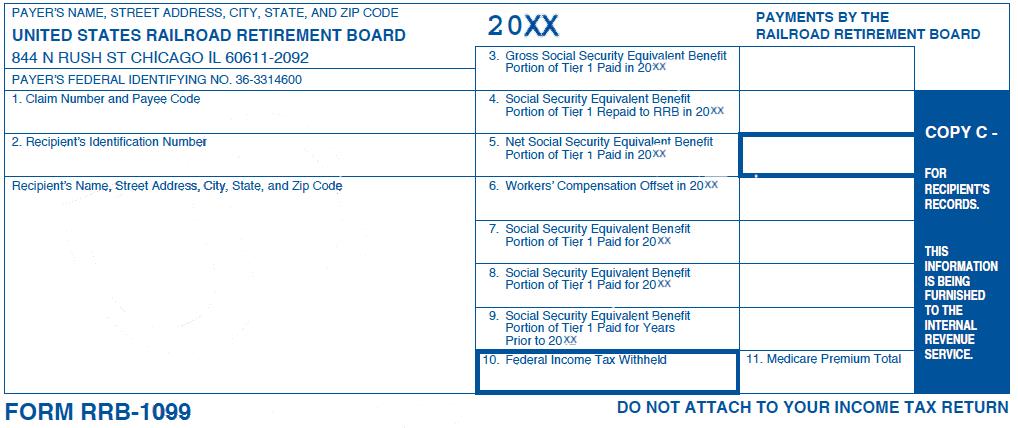
- Box 3: Gross Social Security Equivalent Benefit Portion of Tier I Paid — Your total SSEB payments during the indicated year.
- Box 4: Social Security Equivalent Benefit Portion of Tier I Repaid to RRB — This shows any SSEB benefits you repaid to the RRB during the indicated year, including returned payments, refunds, or amounts withheld from your annuity for overpayment recovery.
- Box 5: Net Social Security Equivalent Benefit Portion of Tier 1 Paid — Your net SSEB payments (Box 3 – Box 4 = Box 5).
- Box 6: Workers Compensation Offset — The amount of workers’ compensation deducted from your SSEB payments, if applicable.
- Box 7: Federal income tax withheld — Any federal income tax withholding from your payments.
- Box 11: Medicare Premium Total — The amount of Medicare premiums deducted from your railroad retirement annuity payments during the year.
Form RRB-1099-R example
Meanwhile, the RRB-1099-R form is green and looks something like this:
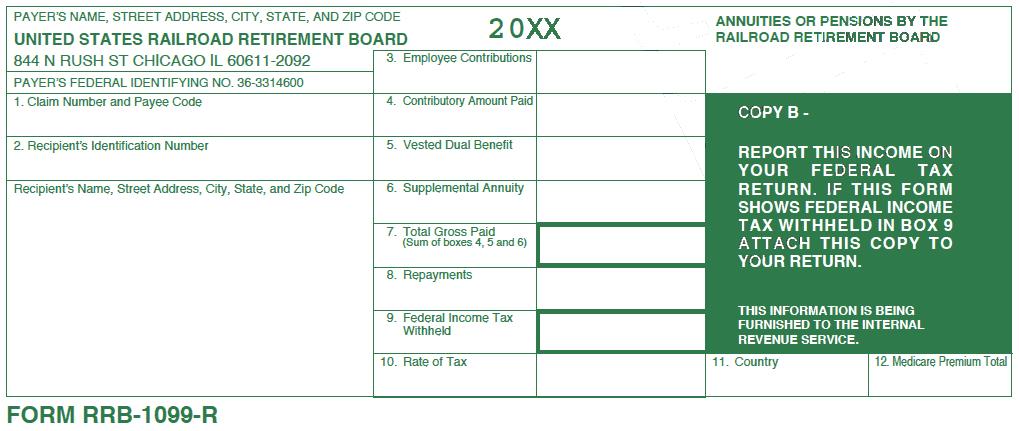
- Box 3: Employee contributions — This amount shows the railroad retirement payroll taxes you paid that exceed what you would have paid in Social Security taxes. The IRS calls this your investment in the contract. If this box is empty, your NSSEB or Tier 2 payments are fully taxable.
- Box 4: Contributory amount paid — The gross NSSEB and Tier 2 b benefits you received during the year (minus any repayments).
- Box 5: Vested Dual Benefit — The gross VDB payments you received during the year (minus any repayments). This amount is fully taxable.
- Box 6: Supplemental Annuity — The gross amount of supplemental payments you received during the year (minus any repayments). This amount is fully taxable.
- Box 7: Total Gross Paid — This box is the sum of Boxes 4, 5, and 6. It represents the total pension paid during the tax year.
- Box 8: Repayments — This shows any prior year repayments (NSSEB, Tier 2, VDB, and supplemental annuity) you made to the RRB this year, if applicable.
- Box 9: Federal income tax withheld — This box reports any federal income tax withheld from your payments.
Instructions for Form 1099-R, Form RRB-1099, and Form RRB-1099-R
Whether you received Form 1099-R or either of the RRB forms, here’s what you should do:
- Check the numbers: Make sure the form you received looks accurate and lines up with your records. If something looks off or you have questions, contact the payer right away to sort things out and get a corrected form, if necessary.
- Determine if any distribution is taxable: This part can get confusing, but e-filing with TaxAct takes out the guesswork. Our tax preparation software will ask questions about each form and help you report it correctly if needed.
- Hold onto the form: It’s good practice to keep tax documents for at least three years after filing, just in case the IRS comes back with any questions. Put your tax forms somewhere safe in case you need them later.
FAQs about Form 1099-R, Form RRB-1099, and Form RRB-1099-R
How do I calculate the taxable amount on 1099-R?
Usually, your plan administrator will calculate your taxable amount and report it in Box 2a. However, if that box is blank, you may need to calculate it based on your contributions and earnings. Not to worry, though — TaxAct can help with this.
Do I have to pay taxes on a 1099-R?
Whether or not you owe tax depends on the type of distribution. For instance, you must pay taxes on distributions from a pre-tax retirement plan, but Roth distributions are tax-free (you already paid taxes on that money when you made your contributions). Or, if you took an early distribution and didn’t meet one of the IRS exceptions, you may owe additional tax.
The taxable portion in Box 2a is subject to federal income taxes and possibly state taxes. TaxAct can help you figure out whether you owe federal or state taxes by asking questions about your Form 1099-R. However, if you want to read more about how specific distributions are taxed, head to the IRS Instructions for Form 1099-R.
How are my railroad retirement benefits taxed?
As a railroad employee, your Tier 1 benefits are taxed at the same rate as Social Security taxes, and the same rules apply. The employee tax rate for Tier 2 benefits in 2024 is 4.9%, with a max amount of $125,100 subject to these taxes.
For additional information, check out the following resources (some have helpful worksheets to determine your taxable income):
- Railroad Retirement Board website
- IRS Publication 915, Social Security and Equivalent Railroad Retirement Benefits
- IRS Publication 575, Pension and Annuity Income
- IRS Publication 939, General Rule for Pensions and Annuities
How to file Form 1099-R with TaxAct
Here’s how you can report your 1099-R form using our tax preparation software:
- From within your TaxAct return (Online or Desktop), click Federal. (On smaller devices, click in the top left corner of your screen, then click Federal).
- Click the Retirement Plan Income dropdown, then click IRA, 401(k), and pension plan distributions (Form 1099-R) as shown below. You can also choose our 1099-R import tool.
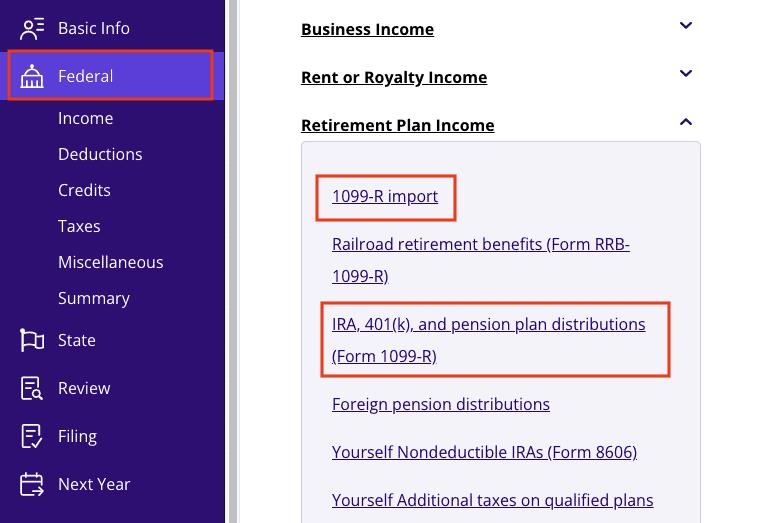
3. Click + Add Form 1099-R to create a new copy of the form or click Edit to edit a form already created. (Desktop program: click Review instead of Edit).
4. Continue with the interview process to enter your information.
How to file Forms RRB-1099 and RRB-1099-R with TaxAct
To report Form RRB-1099 for Social Security Equivalent payments:
- From within your TaxAct return (Online or Desktop), click Federal (on smaller devices, click in the top left corner of your screen, then click Federal).
- Click Social Security Benefits as shown below and continue with the interview process to enter your information.
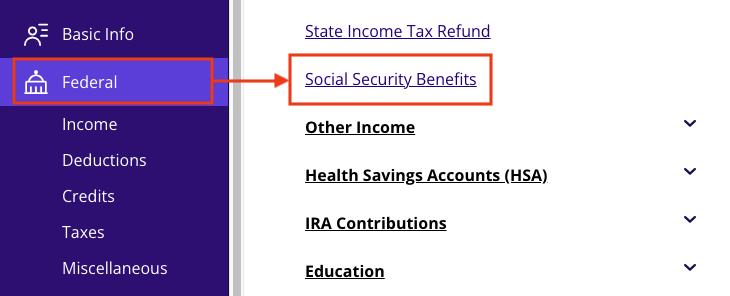
To report Form RRB-1099-R transactions:
- From within your TaxAct return (Online or Desktop), click Federal. (On smaller devices, click in the top left corner of your screen, then click Federal).
- Click the Retirement Plan Income dropdown, then click Railroad retirement benefits (Form RRB-1099-R) as shown below:
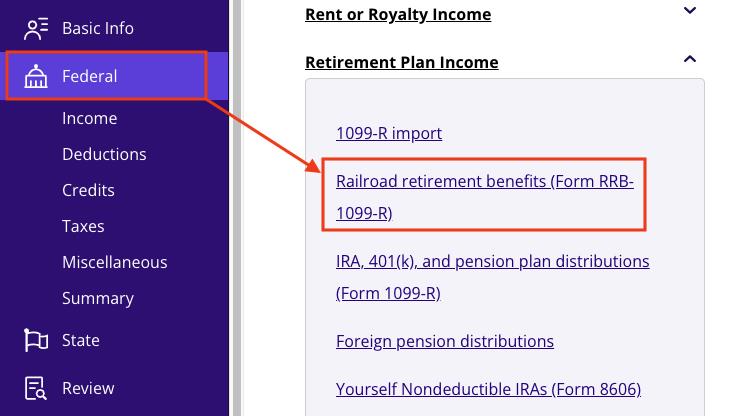
3. Click + Add Form RRB-1099-R to create a new copy of the form or click Edit to edit a form already created (desktop program: click Review instead of Edit).
4. Continue with the interview process to enter your information.
The bottom line
Receiving Form 1099-R or an RRB-1099 form means you have some retirement income to report, but it doesn’t have to complicate your taxes. With TaxAct’s easy-to-use software, you can report your retirement distributions quickly and confidently.
This article is for informational purposes only and not legal or financial advice. All TaxAct offers, products and services are subject to applicable terms and conditions.
The post Form 1099-R, RRB-1099, and RRB-1099-R: What They Are and How to Use Them appeared first on TaxAct Blog.
Read MoreBy: Meghen Ponder
Title: Form 1099-R, RRB-1099, and RRB-1099-R: What They Are and How to Use Them
Sourced From: blog.taxact.com/guide-to-1099-r-and-rrb-1099-forms/
Published Date: Mon, 28 Oct 2024 18:46:23 +0000
----------------------






